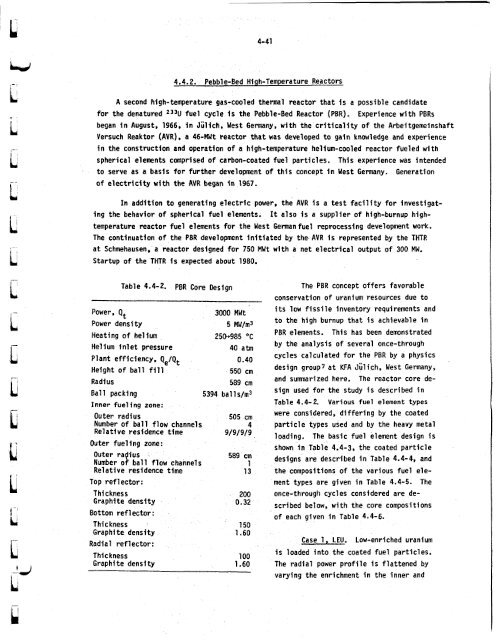ORNL-5388 - the Molten Salt Energy Technologies Web Site
ORNL-5388 - the Molten Salt Energy Technologies Web Site
ORNL-5388 - the Molten Salt Energy Technologies Web Site
Create successful ePaper yourself
Turn your PDF publications into a flip-book with our unique Google optimized e-Paper software.
L<br />
I<br />
1<br />
I<br />
Ld<br />
I<br />
ie<br />
i--<br />
1<br />
t'<br />
4-41<br />
4.4.2. Pebble-Bed High-Temperature Reactors<br />
A second high-temperature gas-cooled <strong>the</strong>rmal reactor that is a possible candidate<br />
for <strong>the</strong> denatured 233U fuel cycle is <strong>the</strong> Pebble-Bed Reactor (PBR). Experience with PBRs<br />
began in Augusta 1966, in JGlich, West Germany, with <strong>the</strong> criticality of <strong>the</strong> Arbeitgemeinshaft<br />
Versuch Reaktor (AVR), a 46-MGlt reactor that was developed to gain knowledge and experience<br />
in <strong>the</strong> construction and operation of a high-temperature helium-cooled reactor fueled with<br />
spherical elements comprised of carbon-coated fuel particles. This experience was intended<br />
to serve as a basis for fur<strong>the</strong>r development of this concept in West Germany.<br />
of electricity with <strong>the</strong> AVR began in 1967.<br />
Generation<br />
In addition to generating electric power, <strong>the</strong> AVR is a test facility for investigat-<br />
ing <strong>the</strong> behavior of spherical fuel elements. It also is a supplier of high-burnup high-<br />
temperature reactor fuel elements for <strong>the</strong> West German fuel reprocessing development work.<br />
The continuation of <strong>the</strong> PBR development initiated by <strong>the</strong> AVR is represented by <strong>the</strong> THTR<br />
at Schmehausen, a reactor designed for 750 MWt with a net electrical output of 300 MW.<br />
Startup of <strong>the</strong> THTR is expected about 1980.<br />
Table 4.4-2. PBR Core Design<br />
Power, Qt 3000 MWt<br />
Power density 5 MW/m3<br />
Heating of he1 ium 25b985 OC<br />
He1 ium i nl et pressure 40 atm<br />
P 1 ant ef f i ci ency , Qe/Qt 0.40<br />
Height of ball fill 550 cm<br />
Radius 589 cm<br />
Ball packing 5394 ball s/m3<br />
Inner fueling zone:<br />
Outer radius<br />
Number of ball flow channels<br />
505 cm<br />
4<br />
Relative residence time 9/9/9/9<br />
Outer fueling zone:<br />
Outer Number rarus<br />
o ball flow channels<br />
Re1 ati ve residence time<br />
Top reflector:<br />
589 cm<br />
1<br />
13<br />
Thickness 200<br />
Graphite density 0.32<br />
Bottom reflector:<br />
Thickness 150<br />
Graphite density 1.60<br />
Radial ref lector:<br />
Thickness 100<br />
Graphite density 1.60<br />
The PBR concept offers favorable<br />
conservation of uranium resources due to<br />
its low fissile inventory requirements and<br />
to <strong>the</strong> high burnup that is achievable in<br />
PBR elements. This has been demonstrated<br />
by <strong>the</strong> analysis of several once-through<br />
cycles calculated for <strong>the</strong> PBR by a physics<br />
design group7 at KFA Julich, West Germany,<br />
and summarized here. The reactor core de-<br />
sign used for <strong>the</strong> study is described in<br />
Table 4.4-2 Various fuel element types<br />
were considered, differing by <strong>the</strong> coated<br />
particle types used and by <strong>the</strong> heavy metal<br />
loading. The basic fuel element design is<br />
shown in Table 4.4-3, <strong>the</strong> coated particle<br />
designs are described in Table 4.4-4, and<br />
<strong>the</strong> compositions of <strong>the</strong> various fuel ele-<br />
ment types are given in Table 4.4-5. The<br />
once-through cycles considered are de-<br />
scribed below, with <strong>the</strong> core compositions<br />
of each given in Table 4.4-6.<br />
Case 1, LEU, Low-enriched uranium<br />
is loaded into <strong>the</strong> coated fuel particles.<br />
The radial power profile is flattened by<br />
varying <strong>the</strong> enrichment in <strong>the</strong> inner and



![Review of Molten Salt Reactor Physics Calculations [Disc 2]](https://img.yumpu.com/21979492/1/190x247/review-of-molten-salt-reactor-physics-calculations-disc-2.jpg?quality=85)












